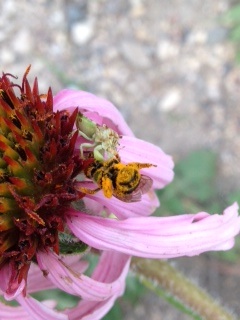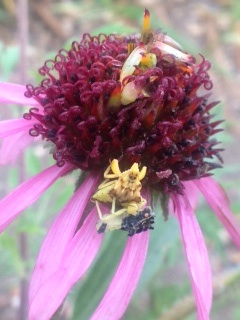Around the middle of peak flowering, a new character began appearing on Echinacea
heads. This is the ambush bug, the endearing name given to this insect, which looks like either a preying mantis or a miniature T-rex. As I do phenology I incidentally happen upon these bugs. Often times I will see an ambush bug on the same head over multiple phenology days. It appears that they prefer heads that are mid-flowering and they sit on the styles which are present below the row of anthers that are presenting pollen that day. I think that there may be a connection between a lack of shriveled styles and the presence of ambush bugs. Ambush bugs- members of the subfamily phymatinae- are predatory insects which lie in wait for other insects to land on the Echinacea head and then pounce. I enjoy taking advantage of this instinct by waving my pen in front of an ambush bug which will bat at the tip with their claw like front legs.
On August 2nd I found an ambush bug with prey in hand on a head at Steven’s Approach. You can see in the photo below that the ambush bug trapped a pollinator. The pollinator was still wiggling its leg bug the ambush bug maintained its grip.
This photo gives evidence of a potential mechanism for the hypothesized interference of style shriveling caused by ambush bugs. If the ambush bug pounces on a pollinator before said pollinator makes its rounds on a head, the styles will not receive compatible pollen and so will not shrivel. I think that the relationship of the ambush bug, pollinators and style shriveling would be a very interesting independent research project in the future.
Below is a photo of two mating ambush bugs. I first spotted this pair on August 8th on a head at East Riley. I was surprised to find that these bugs were in the same location two days later on August 10th. In this photo you can see the abundance of persistent flowers on this head. In addition, you can see that some of the florets are engorged and pushed up. This is most likely the result of a caterpillar or larvae predating on the flower or growing below the florets. Stay tuned to hear more about the saga of the ambush bug!



Leave a Reply